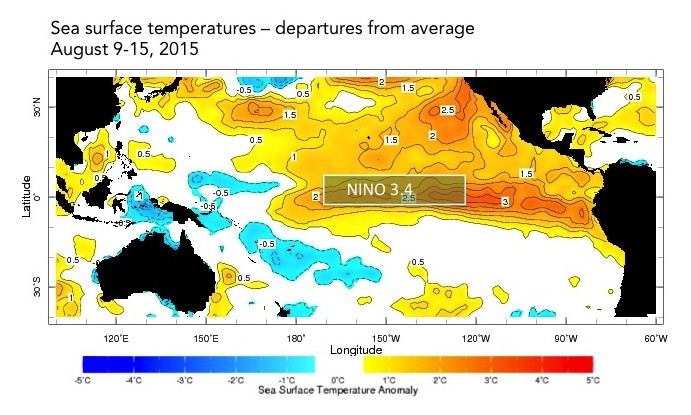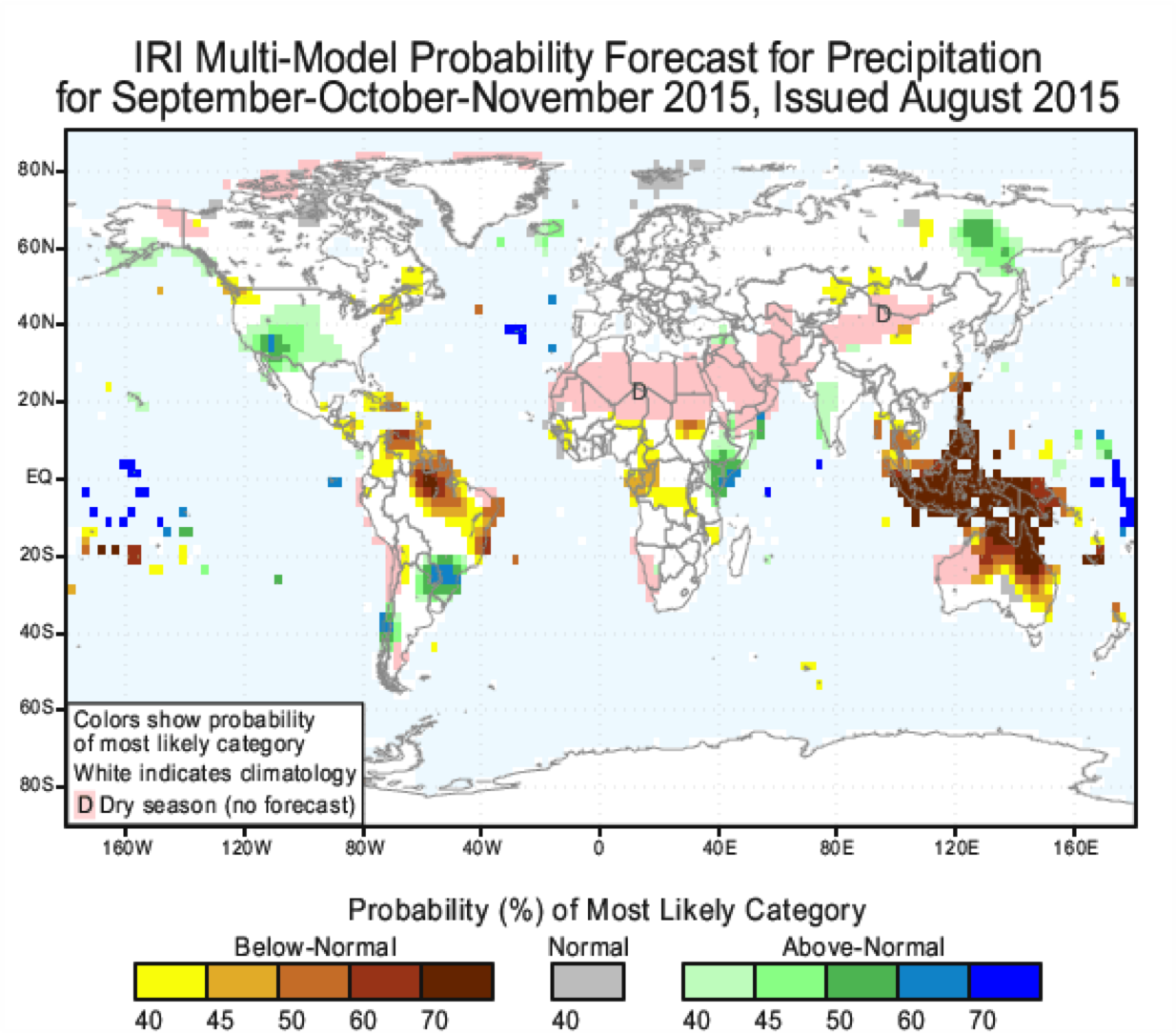August Climate Briefing: “100%” El Niño
Read our ENSO Essentials & Impacts pages for more about El Niño.
Tony Barnston provides an overview of the briefing
Changes from last month’s briefing

The IRI/CPC probabilistic ENSO forecast issued mid-August 2015. Note that bars indicate likelihood of El Niño occurring, not its potential strength. Unlike the official ENSO forecast issued at the beginning of each month, IRI and CPC issue this updated forecast based solely on model outputs. The official forecast, available at http://1.usa.gov/1j9gA8b, also incorporates human judgement.
Although 100% is technically not an achievable number in the world of ENSO and climate prediction, this El Niño forecast all but reaches it for the next several months. The odds are similar to last month’s forecasts, but even just a little bit higher. There is a >99.5% chance of El Niño continuing through the November-January season, and chances stay above 90% through early spring.

These probability calculations are based only on the chance of at least weak El Niño conditions persisting. Nonetheless, the El Niño has continued to strengthen, and Barnston says this event may be in the top four strongest events since 1950. Last week, sea surface temperatures (SSTs) in the Nino3.4 region were 2.0ºC above average (see image). The SST anomaly for the month of July was 1.6ºC. This tops the threshold (1.5ºC) and required length of time (1 month) for a “strong” El Niño to be declared, according to criteria set by the National Oceanic and Atmospheric Administration.

The following graph shows forecasts made by dynamical and statistical models for SST in the Nino 3.4 region for nine overlapping 3-month periods. Note that the expected skills of the models, based on historical performance, are not equal to one another.
To predict El Niño, computers model the SSTs in the Nino3.4 region over the next several months. The graph below shows the outputs of these models, some of which use equations based on our physical understanding of the system (called dynamical models), and some of which used statistics, based on the long record of historical observations.
The mean of both statistical and dynamical models call for an event peaking above the +1.5ºC strong El Niño threshold. The average of the dynamical models is stronger, with a peak strength nearly reaching the 2.5ºC mark (up from a peak strength of about 2.0ºC last month). While the variation among the model outputs is significant, all of the models call for at least a weak El Niño through the end of the year.
The El Niño advisory issued in March by the National Oceanic and Atmospheric Administration’s Climate Prediction Center and IRI is still in effect.
Effects of El Niño on global seasonal forecasts
Each month, IRI issues seasonal climate forecasts for the entire globe. These forecasts take into account the latest ENSO SST projections and indicate which areas are more likely to see above or below normal temperatures and rainfall.

For the September-November period, the forecast continues to show a strong likelihood of drier-than-normal conditions over Indonesia, northern South America, northern Australia and the Caribbean (image right). There are also increased odds for drier-than-normal conditions in parts of central and western Africa, the northeastern US and Central America. Wetter-than-average conditions are predicted to be more likely in parts of eastern Africa, southeastern South America, central Chile and the southwestern US.
Forecasts for the end of 2015 and beginning of 2016 are also showing typical El Niño climate impacts. In addition to the areas listed above, other areas with strong seasonal forecast signals later in the year include eastern Europe, far eastern Asia, the southeastern US, southern Africa, western Australia and southwestern Asia. See forecast maps through the December-February season on our seasonal forecast page.
Learn more about El Niño on our ENSO resources page, and sign up here to get notified when the next forecast is issued. In the meantime, check out #IRIforecast or use #ENSOQandA on Twitter to ask your El Niño questions.

You must be logged in to post a comment.